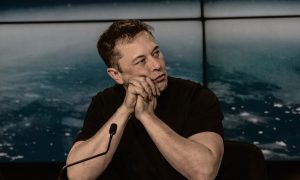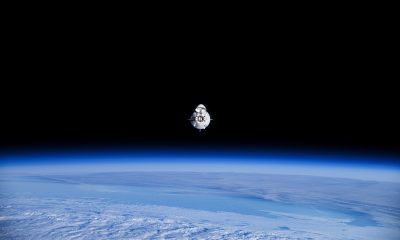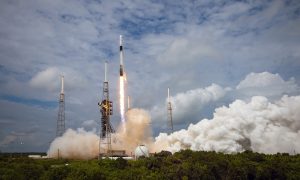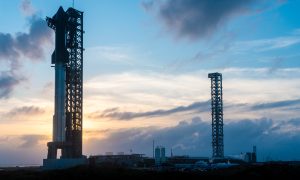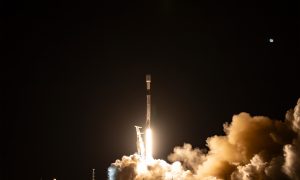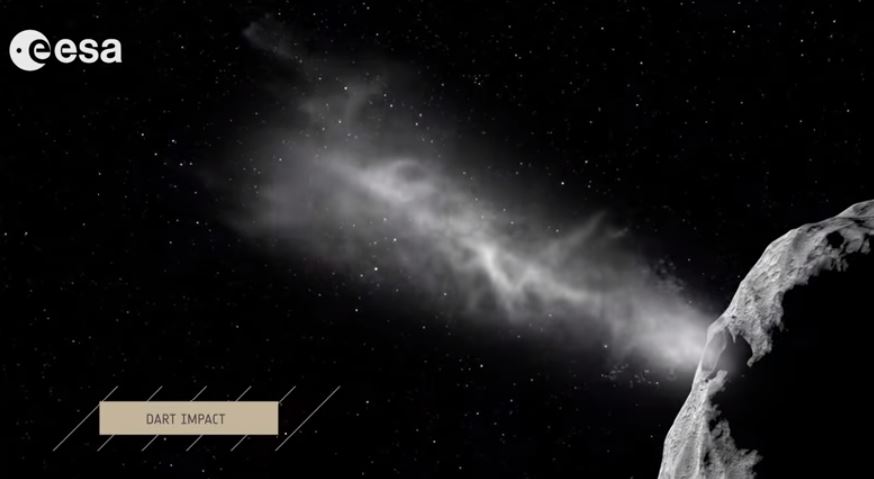

News
NASA is crashing a satellite into an asteroid to gather data about asteroid deflection
The threat of asteroids crashing into Earth isn’t a new concern. We’ve been warned about it by science fiction authors and Hollywood alike, and any kid that’s ever paid attention to dinosaurs in school knows there are bad outcomes when life and chunks of space rock meet up. The space agencies of Europe and the United States are not blind to the threat, thankfully, and they have a multi-part satellite mission in the works directed to gathering real data on how to redirect an asteroid with bad intentions for our planet, i.e., is on a collision course. Specifically, they’re planning on crashing one satellite into an asteroid and studying the effect with another satellite run by the European Space Agency (ESA).
NASA’s part of the mission is called the Double Asteroid Redirection Test (DART), and it will serve as the first demonstration of changing asteroid motion in space. The launch window begins in late December 2020, most likely on track for June 2021, for arrival at its targeted asteroid, Didymos, in early October 2022. Didymos is Greek for “twin”, the name being chosen because it’s a binary system with two bodies: Didymos the asteroid, about a half mile across, and Didymoon the moonlet, about 530 feet across, acting as a moonlet. The two currently have a Sun-centric orbit and will have a distant approach to Earth around the same time as DART’s launch window and then again in 2024.
After reaching the asteroid, DART will enter orbit around Didymoon, and crash into it at a speed of about 4 mi/s (nine times faster than a bullet) to change its speed by a fraction of one percent, an amount measurable by Earth-based telescopes for easy study. Unsurprisingly, the preferred description is “kinetic impact technique” rather than “crash” – maybe even “impact” or “strike”, if we’re avoiding terms that sound random or accidental. The mission is being led by the Johns Hopkins Applied Physics Laboratory (JHU/APL) and managed by the Planetary Missions Program Office at Marshall Space Flight Center in Alabama for NASA’s Planetary Defense Coordination Office.

NASA’s DART mission is one of two parts of an overall mission dubbed AIDA (Asteroid Impact & Deflection Assessment). Joining the agency’s Earth-protection venture is the ESA with its Hera spacecraft, named after the Greek goddess of marriage, a probe that will follow up DART’s mission with a detailed survey of the asteroid’s response to the impact. Collected data will help formulate planetary defense plans by providing detailed analysis from DART’s real-time asteroid deflection experiment. Its launch is scheduled for 2023.
Just this month, another part was added to Hera’s mission: CubeSats. This class of tiny satellites is about the size of a briefcase, and they recently made their deep space debut during NASA’s Mars InSight landing. During that mission, twin CubeSats collectively named MarCO followed along on the journey to Mars behind InSight, eventually relaying data during the landing event back to NASA’s Mission Control along with a photo of the red planet. ESA’s CubeSats, named APEX (Asteroid Prospection Explorer) and Juventas, will travel inside Hera, gather data on Didymos and its moonlet, and then both will land on their respective rocks and provide imaging from the surface.

Just to recap: Tiny satellites in a class that students and startups can and have developed and launched will travel into deep space and land on asteroids. This is big news for the democratization of space travel. As emphasized by Paolo Martino, Hera’s lead engineer in ESA’s article announcing the CubeSat mission, “The idea of building CubeSats for deep space is relatively new, but was recently validated by NASA’s InSight landing on Mars last November.”
Using kinetic energy – pure ram/crash force – isn’t the only option NASA is looking at for defending Earth from incoming asteroids. A “gravity tractor” concept would orbit a craft in a way that would change the trajectory due to gravitational tugging. Similar to how our moon has an impact on our tides or the Earth makes the Sun wobble ever so slightly, a satellite orbiting an asteroid would give pushes and pulls to set its course elsewhere.
Unfortunately, a gravity tractor likely wouldn’t be very effective for asteroids large enough to seriously threaten our planet. Also, the techniques for achieving it would require decades to develop and test in space. Laser ablation, or using spacecraft lasers to vaporize asteroid rock to change an asteroid’s course, is another technique NASA has considered, but it might be just as feasible or cost-effective to simply launch projectiles to achieve the same purpose.
Watch the below video for a visual overview of the DART and HERA missions:
News
Tesla begins Robotaxi certification push in Arizona: report
Tesla seems serious about expanding its Robotaxi service to several states in the coming months.

Tesla has initiated discussions with Arizona transportation regulators to certify its driverless Robotaxi service in the state, as per a recent report from Bloomberg News. The move follows Tesla’s launch of its Robotaxi pilot program in Austin, Texas, as well as CEO Elon Musk’s recent comments about the service’s expansion in the Bay Area.
The Arizona Department of Transportation confirmed to Bloomberg that Tesla has reached out to begin the certification process for autonomous ride-sharing operations in the state. While details remain limited, the outreach suggests that Tesla is serious about expanding its driverless Robotaxi service to several territories in the coming months.
The Arizona development comes as Tesla prepares to expand its service area in Austin this weekend, as per CEO Elon Musk in a post on X. Musk also stated that Tesla is targeting the San Francisco Bay Area as its next major market, with a potential launch “in a month or two,” pending regulatory approvals.
Tesla first launched its autonomous ride-hailing program on June 22 in Austin with a small fleet of Model Y vehicles, accompanied by a Tesla employee in the passenger seat to monitor safety. While still classified as a test, Musk has said the program will expand to about 1,000 vehicles in the coming months. Tesla will later upgrade its Robotaxi fleet with the Cyercab, a two-seater that is designed without a steering wheel.
Sightings of Cybercab castings around the Giga Texas complex suggests that Tesla may be ramping the initial trial production of the self-driving two-seater. Tesla, for its part, has noted in the past that volume production of the Cybercab is expected to start sometime next year.
In California, Tesla has already applied for a transportation charter-party carrier permit from the state’s Public Utilities Commission. The company is reportedly taking a phased approach to operating in California, with the Robotaxi service starting with pre-arranged rides for employees in vehicles with safety drivers.
News
Tesla sets November 6 date for 2025 Annual Shareholder Meeting
The automaker announced the date on Thursday in a Form 8-K.

Tesla has scheduled its 2025 annual shareholder meeting for November 6, addressing investor concerns that the company was nearing a legal deadline to hold the event.
The automaker announced the date on Thursday in a Form 8-K submitted to the United States Securities and Exchange Commission (SEC). The company also listed a new proposal submission deadline of July 31 for items to be included in the proxy statement.
Tesla’s announcement followed calls from a group of 27 shareholders, including the leaders of large public pension funds, which urged Tesla’s board to formally set the meeting date, as noted in a report from The Wall Street Journal.
The group noted that under Texas law, where Tesla is now incorporated, companies must hold annual meetings within 13 months of the last one if requested by shareholders. Tesla’s previous annual shareholder meeting was held on June 13, 2024, which placed the July 13 deadline in focus.
Tesla originally stated in its 2024 annual report that it would file its proxy statement by the end of April. However, an amended filing on April 30 indicated that the Board of Directors had not yet finalized a meeting date, at least at the time.
The April filing also confirmed that Tesla’s board had formed a special committee to evaluate certain matters related to CEO Elon Musk’s compensation plan. Musk’s CEO performance award remains at the center of a lengthy legal dispute in Delaware, Tesla’s former state of incorporation.
Due to the aftermath of Musk’s legal dispute about his compensation plan in Delaware, he has not been paid for his work at Tesla for several years. Musk, for his part, has noted that he is more concerned about his voting stake in Tesla than his actual salary.
At last year’s annual meeting, TSLA shareholders voted to reapprove Elon Musk’s compensation plan and ratified Tesla’s decision to relocate its legal domicile from Delaware to Texas.
Elon Musk
Grok coming to Tesla vehicles next week “at the latest:” Elon Musk
Grok’s rollout to Tesla vehicles is expected to begin next week at the latest.

Elon Musk announced on Thursday that Grok, the large language model developed by his startup xAI, will soon be available in Tesla vehicles. Grok’s rollout to Tesla vehicles is expected to begin next week at the latest, further deepening the ties between the two Elon Musk-led companies.
Tesla–xAI synergy
Musk confirmed the news on X shortly after livestreaming the release of Grok 4, xAI’s latest large language model. “Grok is coming to Tesla vehicles very soon. Next week at the latest,” Musk wrote in a post on social media platform X.
During the livestream, Musk and several members of the xAI team highlighted several upgrades to Grok 4’s voice capabilities and performance metrics, positioning the LLM as competitive with top-tier models from OpenAI and Google.
The in-vehicle integration of Grok marks a new chapter in Tesla’s AI development. While Tesla has long relied on in-house systems for autonomous driving and energy optimization, Grok’s integration would introduce conversational AI directly into its vehicles’ user experience. This integration could potentially improve customer interaction inside Tesla vehicles.
xAI and Tesla’s collaborative footprint
Grok’s upcoming rollout to Tesla vehicles adds to a growing business relationship between Tesla and xAI. Earlier this year, Tesla disclosed that it generated $198.3 million in revenue from commercial, consulting, and support agreements with xAI, as noted in a report from Bloomberg News. A large portion of that amount, however, came from the sale of Megapack energy storage systems to the artificial intelligence startup.
In July 2023, Musk polled X users about whether Tesla should invest $5 billion in xAI. While no formal investment has been made so far, 68% of poll participants voted yes, and Musk has since stated that the idea would be discussed with Tesla’s board.
-

 Elon Musk1 week ago
Elon Musk1 week agoTesla investors will be shocked by Jim Cramer’s latest assessment
-

 Elon Musk19 hours ago
Elon Musk19 hours agoxAI launches Grok 4 with new $300/month SuperGrok Heavy subscription
-

 Elon Musk3 days ago
Elon Musk3 days agoElon Musk confirms Grok 4 launch on July 9 with livestream event
-

 News7 days ago
News7 days agoTesla Model 3 ranks as the safest new car in Europe for 2025, per Euro NCAP tests
-

 Elon Musk2 weeks ago
Elon Musk2 weeks agoA Tesla just delivered itself to a customer autonomously, Elon Musk confirms
-

 Elon Musk1 week ago
Elon Musk1 week agoxAI’s Memphis data center receives air permit despite community criticism
-

 Elon Musk2 weeks ago
Elon Musk2 weeks agoTesla’s Omead Afshar, known as Elon Musk’s right-hand man, leaves company: reports
-

 News2 weeks ago
News2 weeks agoXiaomi CEO congratulates Tesla on first FSD delivery: “We have to continue learning!”


